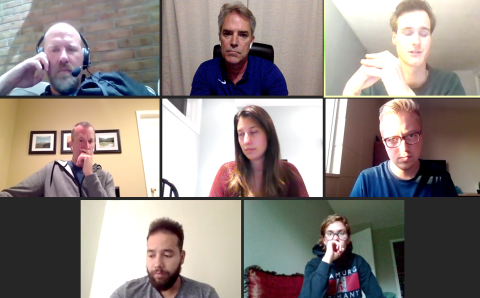“Feliz Navidad!” These are the Spanish words for “Merry Christmas” that we love to say and sing in December. Feliz means merry or happy, and Navidad is connected to the English word “nativity” and means “arisen from birth.” So when we say “Feliz Navidad,” we are celebrating the Savior who, 33 years before he rose from the grave, was raised to life in a manger in Bethlehem.
We can hardly say this season’s greeting without first cracking a smile and knowing in our hearts that we are sharing in a joy that is beyond us and yet inside of us. The words Feliz Navidad decorate Christmas with a Latin flavor, helping us to understand that Christmas is universal and, more importantly, that Jesus is universal. Have you ever noticed how Spanish has a way of rolling off our tongues? Whether it’s Doris Day singing “Que Sera, Sera” or Arnold Schwarzenegger growling “Hasta la vista, baby,” Spanish is a Romance language, full of fun and full of passion, and I can tell you that Hispanics have a lot of love for family, culture, and the Lord Jesus Christ.
What’s in a Name?
Three of the most popular names in Spanish are José, Maria, and Jesús. Translated into English these names are Joseph, Mary, and Jesus. Latinos don’t have to look very far to find the holy family within their own families. My uncle’s name is José, my mother’s name is Maria, and my cousin’s name is Jesús de Emanuel, which means Jesus of Immanuel.
Who would name their child Jesus? Some might exclaim, “You are setting up that child to fail!” But someone else might say, “You are setting up that child to succeed!” After all, that’s what going through the waters of baptism means: God is placing his name on us. So why not name your child after the name that is above every other name?
My name is Felix, a name that’s in the Bible. The Bible even addresses Felix as “most excellent” (Acts 24:3). Never mind that Governor Felix, while he was sitting next to his Jewish wife, Drusilla, rejected the gospel message when he heard the apostle Paul speak about living a godly life and the coming judgment. The point is that I’m part of the story! That’s what most Latinos want more than anything else for every single member in their family: to be part of the greatest story ever told—the story of Jesus! There are two particular ways that Latinos enter the story of Christ at Christmastime.
Noche Buena
The first way we celebrate Christmas is through Noche Buena. In Spanish, buenas noches means “good evening” or “good night.” But when we reverse the order of these words and say “Noche Buena,” we are specifically referring to Christmas Eve. This is the most sacred day in the Latino calendar.
To appreciate what Noche Buena means to Hispanics, we have to see Christmas the same way that Jewish people understand the 24-hour day. In Genesis 1:5, the Bible says, “There was evening and there was morning—the first day.” In the Jewish mindset, a new day begins when the sun sets, not when the sun rises. This is the first step to understanding why December 24 is so much more important than December 25 in the Latino understanding of Christmas. We know the shepherds outside of Bethlehem were keeping watch over their flocks by night when the angels appeared to them, announcing the birth of Christ. I trust we all understand this to mean Jesus was born the night before the day we have chosen to call Christmas. And because Jesus was born the night before Christmas, that’s when Hispanics get together to celebrate the birth of Christ.
Many people from Mexico and Guatemala prepare for Noche Buena by observing something called Las Posadas in the weeks before Christmas. Posada comes from the word meaning “to rest.” During Las Posadas, two people in the community take on the roles of Joseph and Mary and go to different homes in the neighborhood, knocking on doors and asking if there is any room in the home for Joseph and Mary to stay or rest. Imagine a large group of people from your neighborhood showing up at your doorstep singing, beating on homemade musical instruments such as turtle shells, and asking if there is room for Joseph and Mary. If the residents in the home say there is no room, they are expected to join the procession to the next home to ask the same question. This process is repeated until the band of travelers arrive at a pre-designated home that welcomes the group (and Joseph and Mary) into their home for a night of celebration with food, piñatas, and Roman Catholic rituals reserved for that evening.
Puerto Ricans similarly celebrate during Christmastime with a parranda, which means “party.” Parrandas are very similar to posadas, but the idea behind a parranda is to surprise a homeowner with a group of Christmas carolers on their doorstep. If the party shows up at your home, it’s your responsibility to welcome the carolers in and feed them. Once the group is done eating your food, it’s your job to join them on their way to their next stop that same evening.
Whether Latin Americans prepare for Christmas Eve with a posada or a parranda, the understanding is that every mini fiesta is building up to the greatest fiesta of the year: Noche Buena.
Growing up in Miami, I felt as if Noche Buena was the most important night of the year. It seemed as if every aunt and uncle and every first, second, and even third cousin was invited to my house for the party. It didn’t matter if the people walking through my front door were blood relatives or not; everyone under one’s roof on Noche Buena is treated like family and welcomed with a hug and a kiss. Both of my parents are from the Dominican Republic, and the only other place I saw so many Dominicans gathered together was on the island of Hispaniola. On Noche Buena you could call my house a “little Dominican Republic.”
If the Noche Buena invitation says the celebration starts at 6 p.m., it doesn’t really get going until 8 p.m. Latinos as a whole are not known for being punctual. For the most part, we keep time differently from our Anglo brothers and sisters in Christ. We are more a kairos than chronos kind of people.
In the New Testament, there are two different words for time: chronos and kairos. Chronos is more concerned with the traditional sense of time. It’s about when things start and when things end. But kairos is different. Kairos is focused on making the most of the time. Don’t be discouraged when Latinos fail to keep chronos time, because when we eventually walk through those doors, kairos time is about to begin. We are talking about the most rhythmic music you have ever danced to, the most flavorful food you have ever tasted, and the funniest stories you have ever heard. But the goal of every Noche Buena celebration is to make it to midnight. It is precisely at midnight that something amazing happens: you get to open your Christmas presents! (Do you have any idea how hard it is for a 7-year-old to make it to midnight without falling asleep? I know. I can remember.)
El Dia de los Reyes Magos
For old-school Hispanics, opening presents on Christmas is still considered a novelty. They will tell you that Christmas is not the day to give and receive presents. Christmas is about celebrating Christ.
This brings us to the second-most important day on the Latino calendar during the Christmas season: Jan. 6, the day commonly referred to in Spanish as el Día de los Reyes Magos (Three Kings Day). This is the day for presents.
It was the Magi who, following the star to Bethlehem, brought the newborn king gifts of gold, frankincense, and myrrh. The traditional way of thinking is that since the Magi brought Jesus gifts, then on the day we commemorate the Three Kings we too should share gifts with each other.
You need to know that Hispanics love the Magi. We rely heavily on church tradition for the names of the three kings: Melchior, Caspar, and Balthasar. Melchior is said to be the one who gave Jesus the gift of gold. He is described as an old, white-haired man with a full beard. Caspar is said to be the youngest of the group—he didn’t even have a beard! It’s said he gave baby Jesus the gift of frankincense. Lastly, Balthasar is said to be the dark-skinned, dark-haired, full-bearded wise man who gave Jesus the gift of myrrh.
There is still a parade every year on Calle Ocho in Miami’s Little Havana that celebrates Three Kings Day. While I lived in central Florida, a church hosted a special celebration every Jan. 6 for their predominantly Hispanic congregation to commemorate the arrival of the Magi.
Changing Times
Despite the traditionalist’s firm grip on the way things should be in the Latino community, times are continually changing. With the Latinization of North America, Hispanics in the United States have slowly adapted their customs and traditions to fit the times and the country in which they now live. I didn’t realize that when we opened our presents at midnight it signaled a shift in the customs of our culture. That’s true for every Latino, whether you are a Cuban in Miami, a Dominican in New York City, a Colombian in Chicago, an El Salvadorian in Los Angeles, or a Mexican in Dallas.
Today, my three children are all teenagers. They grew up differently than I did. Both of my parents were immigrants from the Dominican Republic, but my children were born to parents who were both born in the United States. I was born and raised in Miami; my wife, of Scottish and Hungarian descent, grew up in Pennsylvania.
This means that my children grew up in a home in which the parents took the best Christmas traditions of both worlds (Latino and Anglo) and made it work for the children in a new way. We’ve raised our children to appreciate Christmas as a two-day celebration including both Christmas Eve and Christmas Day. Our children don’t have to stay up until midnight to open their presents Dec. 24. Right when we get home from the Christmas Eve service, each opens one present in honor of Noche Buena. On Christmas morning they open the rest. Then, on el Dia de los Reyes Magos, it’s been my tradition to give each of my children at least one present to help them remember the significance of Jan. 6, both in the church calendar and our Latino heritage.
This is the way we say "Feliz Navidad" in 2020. Many of us are familiar with this greeting because of the 1970 song by Puerto Rican native José Feliciano. It’s amazing how such a simple song has captured the hearts of millions throughout the world for half a century. Many people who love “Feliz Navidad” may not know that Feliciano is blind. Like Ray Charles, Stevie Wonder and Andrea Bocelli, he is a gifted musician who, though unable to see, is able to open our eyes to an invisible beauty through his art. My prayer is that God will use this article to open your eyes to the wonder of a Savior who is still being born anew in the hearts of different cultures.
About the Author
Felix Fernandez is pastor of South Kendall Community Church Miami, FL.







